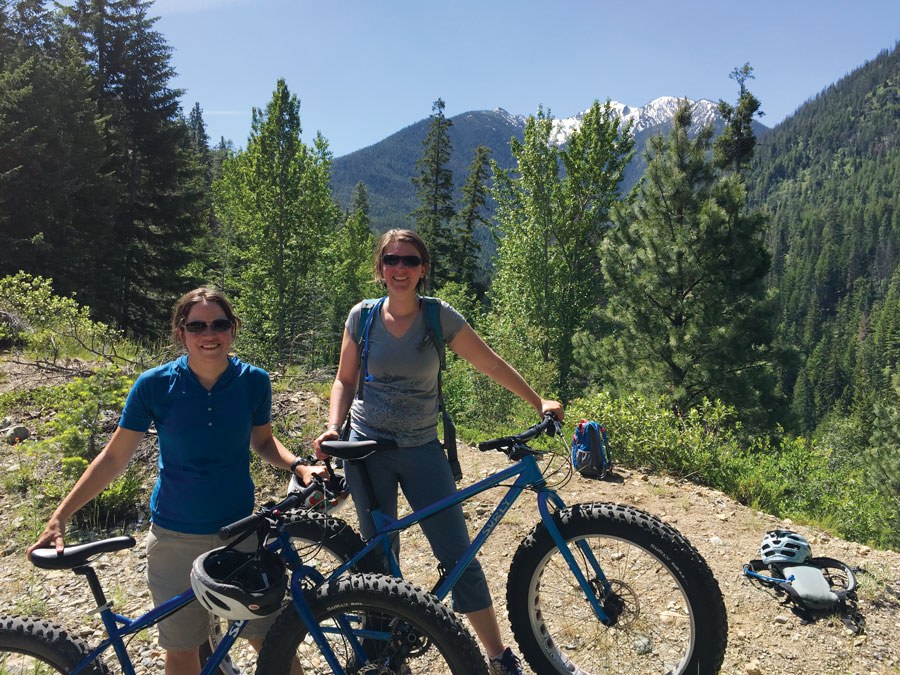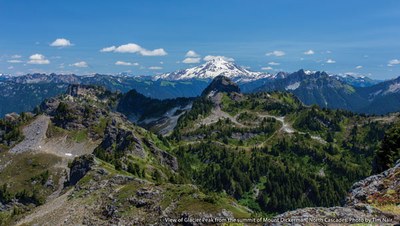
by Leone Kraus, Corporate and Foundation Relations Manager
My wife and I moved to Seattle nearly three years ago from Brooklyn, New York. It took us less than a year to decide to make Seattle our forever home. For outdoor lovers like us, how could we not? In under an hour on any given day, we can be on the trails headed to our campsite, in the mountains getting ready for a day of snowshoeing, or on the water in a kayak.
We simply couldn’t do this in New York. It would take us the same amount of time just to navigate Brooklyn traffic into Manhattan, to catch the highway north out of the city toward the Catskills. Seattle has opened our eyes to how amazing it is to live in a city surrounded by accessible mountains and waters.
Though I work for an outdoor organization, I spend a lot of time with people who work in the technology industry. I lead the Seattle chapter of a global group that connects diverse audiences in tech for a variety of monthly networking and panel events.
When I joined The Mountaineers, I envisioned I would have to release myself of this leadership role. Instead, I discovered natural overlaps between tech and the outdoors. For example, tech’s effort to grow diversity overlaps with the outdoor industry’s efforts to expand diversity — and both are necessary in order to take on some of our world’s biggest environmental challenges. So I decided to keep running the group and write about tech for our Mountaineer magazine.
Growth of Tech in the Greater Seattle Area
Seattle is frequently listed at the top for most livable city due to proximity to nature and recently held the title for fastest growing big city in the United States. Tech giants like Microsoft and Amazon have long called the Greater Seattle Area their home. Perhaps these companies set up shop here for the beautiful backdrop of mountains and water that surrounds their offices or they had the foresight to know that access to the outdoors could lead to a more happy and productive workforce. Whatever the reason, these companies picked a beautiful city to build their headquarters.
For years, these companies, along with newer arrivals like Facebook, Google, Apple, Zillow and others have attracted top talent from around the world to relocate to Seattle for jobs. Data from the Bureau of Labor Statistics shows that in 2015, there were approximately 60,000 jobs for developers in the Seattle Metro Area. According to the job site Simply Hired in July 2015, 21,000 jobs had been posted for tech positions, which made up about a quarter of all jobs available at the time. This growth contributed to Seattle’s once held “fastest growing city” title, bringing many new tech employees into the region.
New arrivals are contributing to some of the associated impacts from this growth — including congestion on the city’s roads and highways and the number of building cranes peppering the skyline. Further, as of March 2016, 8.2% of the private sector workforce in Washington works in tech — and these numbers are growing quickly.
Another visible sign of this growth is from Seattle’s changing demographics. Though it has been noted that by 2043, the whole of the minority will be the majority, Seattle may see this shift sooner. According to 2010 census data from Seattle Metro area, 72% of the population identified as Caucasian but as Seattle continues to grow and attract tech talent from around the world, the 2020 census data may show a decline for those who identify solely as Caucasian and an increase in minority populations continues to trend up. Couple this with some of the tech sector’s biggest player’s aggressive efforts to hire more women, people of color and other minorities into tech positions, we’re likely to see an increase in diverse populations in the next census.
Growing Tech Supports Recreation Economy
People in the United States, and especially in Washington State, spend big money to “get outdoors.” According to research found in The Outdoor Recreation Economy report from the Outdoor Industry Association, which analyzes the economic impact of the recreation economy, every year approximately 140 million Americans spend $646 billion dollars in outdoor recreation. This amount takes into account the cost for gear like tents, packs, boots and clothes, vehicles like boats and jet skis, and other travel-related expenses like campground fees and souvenirs. In the state of Washington alone, $22.5 billion is spent on outdoor recreation. In fact, outdoor recreation consumer spending trails just behind Financial Services and Insurance and Outpatient Health Care, which are the two highest areas for consumer spending.
In addition, outdoor recreation provides 227,000 jobs in Washington and 6.1 million nationally. The number of jobs available in the recreation economy will likely increase as demand for more outdoor gear, supplies, and other outdoor recreation needs grow in the future. The Outdoor Industry Association’s report states, “the outdoor recreation economy grew approximately 5% annually between 2005 and 2011 — this during and economic recession when many sectors contracted.” So this tells us that when the chips are down, people are still getting outside for peace of mind.
Tech growth is not responsible for all of this spending, but it is a contributing factor. Though outdoor activities like hiking, mushroom foraging, and bird watching are inexpensive and open to all who have access to transportation and proper clothing. Others, such as skiing, climbing, kayaking, and biking can require an investment into gear and classes. And, many people who work in tech (e.g. developers, engineers, programmers, etc.) are paid well. According to a March 2016 study from CompTIA, the average tech salary in Washington is $130,000, which is the second highest in the nation. (Silicon Valley takes first, with the highest average salary at $150,000). Compare this to 2015 data from the Bureau of Labor Statistics, where the average salary for those in Arts, Design and Media make an average of $60,000 annually and those in Education make about $56,000 annually in the Seattle Metro area and you see the disparities in occupation and value.
Based on the average salary for tech workers ($130,000), we can make the assumption that people who work in tech are likely to have the financial means to engage in a breadth of outdoor recreation activities that require a significant investment thus supporting the recreation economy and the economic stability of the state of Washington.

Does Tech Drive Foot Traffic?
With interest in outdoor recreation increasing and the population of Seattle growing due in part to the growth in the tech sector, we’re going to continue to see a significant increase of foot traffic on our trails from people who want to recreate in the outdoors.
While it’s difficult to track the amount of foot traffic on many of our trails, we can see the impact from visitation in our National Parks. According to the 2015 National Park Visitor Spending Effects, Economic Contributions to Local Communities, States, and the Nation report produced by the National Park Service, in 2015 Olympic National Park saw 3.26 million visitors, Mt. Rainier saw 1.2 million visitors, and the North Cascades saw 20,677 visitors. As we’re in the midst of the National Park Service’s Centennial celebration, the National Park Service estimates they will see an unprecedented lift in visitation across all parks to 300 million visitors in 2016, which is an increase from the 272.5 million in 2015 and the 262.7 million in 2014. This growth suggests that the National Parks in Washington may see an increase in visitation by 3.7% this year — approximately 170,000 more visitors across the parks.
Impacts of Increased Foot Traffic
At the Mountaineers, we know that people protect what they love and love what they know — which is why we embrace getting more people outdoors safely and responsibly. If we teach people about our precious lands and how to care for them while having fun in the outdoors, then they will become stewards for our natural places. In short, we want to welcome Seattle’s — and Tech’s — growth, but not at the detriment of the environment.
A few things I see out there are:
You can find poop behind trees, left behind soiled papers to wipe up poop, dog poop that wasn’t picked up — wait is that dog poop or is that human poop? — everywhere on our trails. Poop does not decompose the way natural plant debris does. In fact, poop is full of toxic chemicals that can negatively affect water sources and change the makeup of the soil.
Food wrappers, tissues, and more have been seen on trails, particularly around areas where stops for lunch and snacks are common place. Waste does not biodegrade and can be incredibly harmful to the animals that may come in contact with them.
Wildlife Disturbance
Leaving wildlife alone is critical to protecting our natural places. Chasing wildlife for that perfect picture is not safe for you and causes fright and distress in the animal. Our wild places are exactly that, wild. Enjoy what we see in nature at a distance and don’t impose on their personal space for your own selfish gain.
People who understand what it means to recreate responsibly know the Leave No Trace principles are able to implement and execute them without hesitation. However, not everyone is a responsible recreationist—not because they don’t want to but rather they don’t know how to be.
How The Mountaineers Helps
Research has proven that getting outdoors and engaging with the natural world can provide significant health benefits by releasing stress that working long hours can have on one’s health and well-being. As Seattle’s population grows, we continue to play a leading role in educating newcomers on how to recreate in the outdoors safely and responsibly. This summer, we’re launching our Backcountry Impact video series to educate on low-impact recreation skills. These videos will be available online and will allow us to grow the community of responsible outdoor recreationists.
Coupled with this is our commitment to train members, volunteers and youth we engage on how to recreate safely and responsibly. Our volunteer-led courses and activities introduce thousands of outdoor recreationists to new skills and abilities. We offer conditioning courses to strengthen muscles required for steeper climbs, and wilderness navigation courses for those who want to go deeper into the backcountry on skis, snowshoes, or by foot. We also offer courses in photography, kayaking, yoga and more — all designed to meet the varied interests of those who love to get outdoors in different ways. In addition to courses and activities, we have a catalogue of over 700 books that engage people in the outdoors safely and responsibly through such titles as Freedom of the Hills or 100 Best Hikes in Washington.
Supporting in the Tech Community
Support from those in the tech community will allow us to advance our vision of creating a more inclusive outdoors — not only in our membership, but also by granting underserved youth who don’t have the opportunities to engage in the outdoors do so through our donor-supported Mountain Workshops program.
There are many ways for tech employees and companies to get involved with The Mountaineers, even beyond what is listed. A lot of employers will match contributions made by employees — or the monetary equivalent of volunteer hours. Together, we can create, cultivate, and adapt to supporting the development of a truly inclusive outdoors.
 3519b6fe382746fbb24aac803264f537
3519b6fe382746fbb24aac803264f537